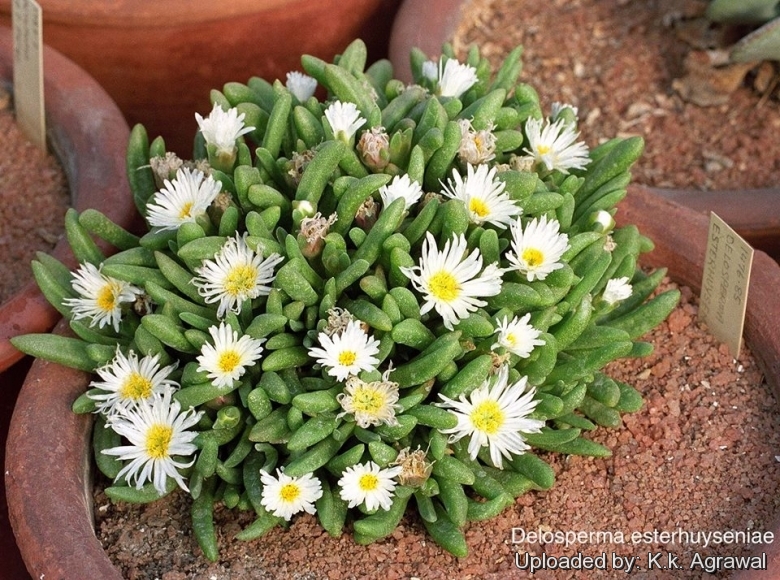




Your support is critical to our success.

Origin and Habitat: South Africa, Western Cape (Cape Province: Adams Kraal, Uniondale, Humansdorp and Langkloof)
Altitude range: Around 700 metres above sea level:
Habitat and Ecology: Delosperma esterhuyseniaeSN|28040]]SN|28040]] grows in rock crevices and cups on quartzitic sandstone cliffs at middle altitude. The species is predominantly winter-growing but benefits from some summer water. It shares its habitat with other cliff-dwelling plants such as Bulbine cremnophila, Cyrtanthus montanus, Cyrtanthus labiatus, Haworthia gracilisSN|21283]]SN|15017]] var. picturata, Haworthia viscosaSN|15017]]SN|21283]], Plectranthus verticillatus, Othonna lobataSN|35344]]SN|35344]], Cotyledon tomentosaSN|27065]]SN|27065]], Adromischus cristatusSN|134]]SN|134]] var. Zeyheri and Albuca cremnophila.
Synonyms:
- Delosperma esterhuyseniae L. Bolus
ENGLISH: Ice Plant
Description: Delosperma esterhuyseniaeSN|28040]]SN|28040]] is a free flowering compact caespitose shrublet, with stems covered by old leaves. It is only an a few centimeters tall but flowers all summer. Unlike most species of this genus, which tend to be rather rampant groundcovers or shrubs, this is a diminutive, compact, plant.
Stems: Its branches up to 3 mm in cross-section, spread about 3-5 cm from a central rootstock but are hidden by rosettes of leaves. Base enclosed by hardened old leaves.
Roots: It has woody roots.
Leaves: Subclavate, erect, apex rounded about 15-30 mm long, , 4-5 mm broad and thick, minutely papillate dark green or blush reddish in bright light.
Blooming Habits: Flowers solitary, bright white, 11-35 mm in diameter. Pedicel 7 mm, in fruits to 26 mm 1ong. Filamentous staminodes absent, filaments white.
Fruits (capsules): About 9 mm in diameter with high rims on valves. The more narrow valve wings are not very common in Delosperma.
Blooming season: Summer (Novenber-March).
Seeds: Almost round, pale brown, about 1 mm broad.
Bibliography: Major references and further lectures
1) Heidrun E.K. Hartmann “Illustrated Handbook of Succulent Plants: Aizoaceae A-E” Springer, 2002
2) Burgoyne, P.M. 2006. Delosperma esterhuyseniae L.Bolus. National Assessment: “Red List of South African Plants” version 2014.1. Accessed on 2014/07/12
3) Peter Goldblatt “Cape Plants: A Conspectus of the Cape Flora of South Africa” National Botanical Institute of South Africa, 2000
Cultivation and Propagation: Delosperma is a genus that require very little maintenance. Delosperma esterhuyseniaeSN|28040]]SN|28040]] seems to do best in rocks crevices, where it has a cool root run. In fact, growing with rocks slows the heating and cooling of the soil and provides sharp drainage and additional water at the same time. However, it is a good container plant too.
Watering: Although they are succulent they need plenty of water. Treating them like other succulents with limited watering will cause their untimely death.
Hardiness: This species can withstand frost (hardiness to -7° C or even less) and can be planted out of doors in northern hemisphere rock-gardens (USDA zone 6 to 8).
Exposure: They seems to enjoy a hot, full sun position in the rockery, where winter snows melt quickly.
Fertilization: Fertilizing this plant really isn't needed as it's already a voracious grower. However, a liquid 10-10-10 diluted to half strength or a cactus fertilizer once a month during spring and summer can benefit the plant.
Repoting: Make sure to repot during its more active period, starting in spring.
Soil: They need well drained soil with less organic material; extra pumice or perlite provides excellent drainage essential to these type of plants.
Pot culture: Plants in pots prefer light afternoon shade in hottest summer days while during the winter they can be watered less often, about every 2-3 weeks. Inside they grow fine on windowsills, and will even bloom, if they get enough direct sunlight.
Propagation: Offsets that form at the base are the easiest way to propagate it, cuttings root readily, but seeds are also an options. Seeds germinate in 7-14 days at 21°C. If they start to rot there is usually part of the plant that can be removed and possibly rooted.
| Your Actions | |
|---|---|
| Back to Delosperma index | |
| Back to Aizoaceae index | |
 |
Back to Succulents Encyclopedia index |
Privacy stantement - Terms and conditions - How to cite - About us - Feedback - Donate




